![]()
|
Wood & Son (s, Ltd) |
|
Location and period of operation:
|
Wood
& Son (s, Ltd) |
Burslem |
1865 |
2005 |
|
Earthenware manufacturer at Burslem, Stoke-on-Trent, England. Wood & Sons was a renowned English pottery
manufacturer based in Burslem, Staffordshire, operating from the mid-19th century into the late 20th century.
Factories:
Associated companies:
- more on the Wood family of Potters -
|
Previously: New Wharf Pottery also incorporating H J Wood

Wood & Sons - 1907
Advert
from..... 1907
Staffordshire Sentinel
'Business Reference Guide to The Potteries, Newcastle & District'
|
the
advert shows traditionally designed |
five
years later this advert places the emphasis |
courtesy: Pottery Gazette Reference Book
Shola China
|
An Edwardian era design in a transfer pattern - the border features a repeating undulating ribbon design in gold colour with shading. Within the ribbon are small green foliage sprigs and the rim has a gilt band. |
 Wood & Sons Burslem England Shola China all of the items in this dinner
set |
 Royal Semi-Porcelain Wood & Son England one cup has this mark - |
|
“Shola China” is a trade name used by Wood & Son(s) - it refers to the semi-porcelain body used for their finer tableware lines, and is not a pattern name. All known examples of Shola China are dinner ware, usually predominantly white/cream with minimal floral and geometric borders. Sometimes the pattern name is included in the mark. photos courtesy: Lori Linda |
"Shola
China" appears to have been introduced in the early 1900s and probably continued in production into the 1920s
|
|
 |
 |
 |
 |
| pattern name: Aquatic |
no pattern name - generally called 'Dragon Fly' This
plate has impressed numbers |
no pattern name - generally called 'Oriental Birds' | covered
serving dish - no name |
examples of patterns in Shola China
Wood's Ivory Ware

traditionally designed floral patterned dinner ware |
 Wood's Ivory Ware England Wood’s Ivory Ware was introduced around 1930 - it was a fine earthenware with a smooth, ivory-like finish. This line was widely used for tableware and decorative pieces, noted for its durability and elegant aesthetic. Production of Ivory Ware
continued |
photos courtesy: John Dupuis

|
c.1910+ probably 1910-20s |
Shard found (Dec 2024) at the Western Cape of South Africa which is home to many old shipwrecks
photos courtesy: Ross Vermeulen
|
- more on the Asiatic Pheasants pattern -
|
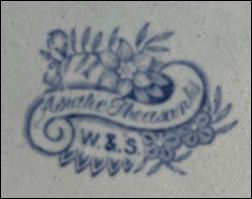 Asiatic Pheasants W. & S. probably produced by Wood & Sons |
photos courtesy: Charlie Dinami
Yuan pattern
 blue & white printed dish in the Yuan pattern note that there were variations in the depiction of the birds
The
pattern was introduced in 1916 and an advert in the 1930s described it as
"a reproduction of a charming oriental design from the 13thC YUAN
dynasty (1280-1367)". Mostly produced as in a blue & white pattern, occasionally in brown. Some variations include gilt banding and rim patterns. Small quantities were made with hand colouring. |
|
Seaforth pattern

plate in the blue & white
Seaforth pattern
|
|
Mark incorporating the Stafford Knot.
|
 Seaforth Enoch 1784 Ralph 1750 Woods Burslem England This style of mark was introduced |
Saxon pattern
|
This
pattern by Wood & Sons is based on a Delft pattern - a number of
other Staffordshire potters produced similar patterns with different
names - Ridgway 'Danish Blue'; Aynsley & Co 'Copenhagen';
Johnson Brothers 'Indies'; Myott 'Finlandia' |
 "SAXON" Made in England Mark incorporating the Stafford Knot. Ware in the Saxon pattern is produced with this mark, having no reference to the manufacturer Wood & Sons |
| Wood's Ivoreen
China: In order to compete against the more expensive but elegant and delicate looking porcelain china, Wood, in common with other manufacturers, improved the manufacture of their earthenware - producing a thinner body. 'Ivoreen China' was introduced in the 1930s but appears to have been discontinued as a trade name during the 1940s. By the early 1950s the only similar name was "Wood's Ivory" Ware. Following the success of the hand-painted patterns designed by Clarice Cliff, Wood & Sons introduced a 'handcraft' range - these patterns were often found on Ivoreen China. Note: at some time the spelling of the name 'Ivoreen' was changed to 'Ivorine'. |
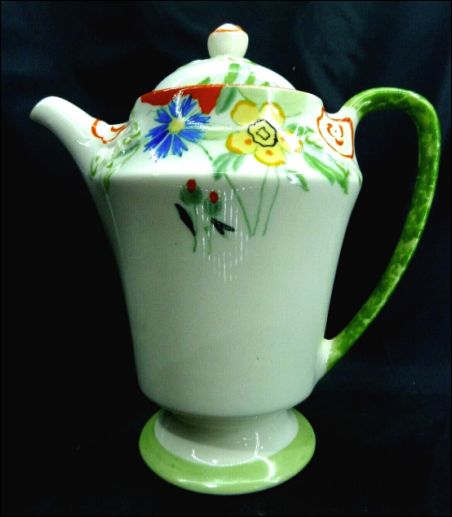 hand painted coffee pot |
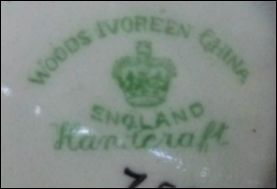 Woods Ivoreen China England Handcraft |
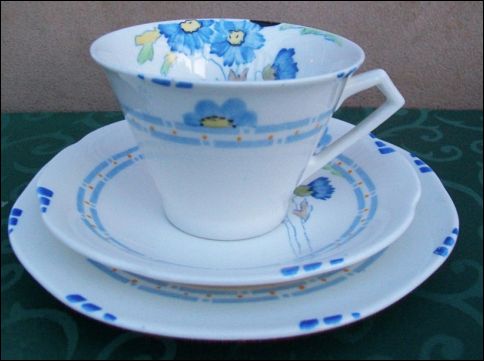 |
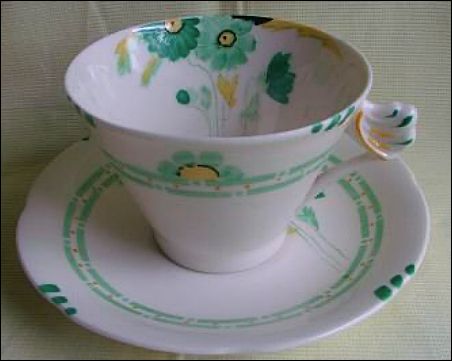 |
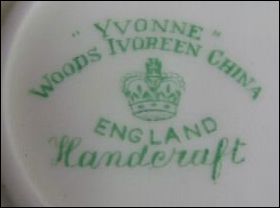 "Yvonne" Woods Ivoreen China England Handcraft |
| ware in the Yvonne pattern in blue and green - with different handle finishes | ||
Tea set in the "Maureen" with differing identification marks
|
Pottery manufacturers were not always consistent with identification marks, even with the same pattern. This tea set is a good example of the inconsistency in marking:
|
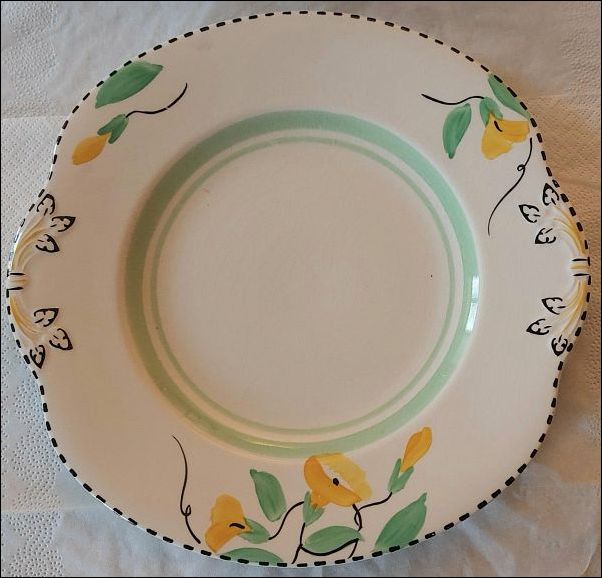 side plate in the Maureen pattern - with yellow flowers |
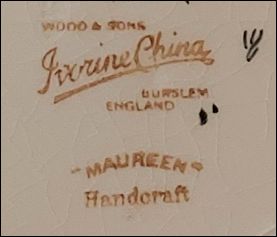 Wood & Sons Ivorine China Burslem England "Maureen" Handcraft
|
|
|
||
| China Wood & Sons England |
Wood
& Sons Ivorine China Burslem England the hand painted marks will be decorator marks |
ENGLAND (moulded mark) |
photos courtesy: Phil & Sue Coles
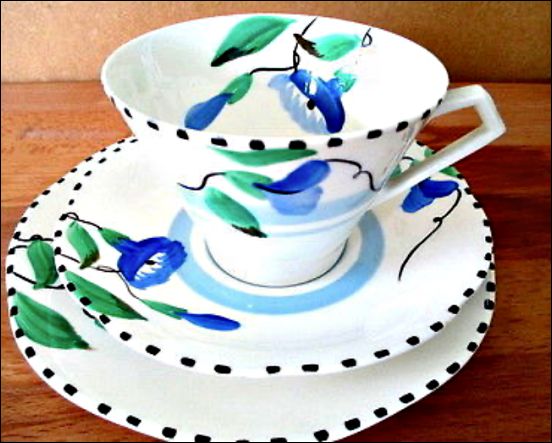
trio in the hand painted
Maureen pattern - with blue flowers
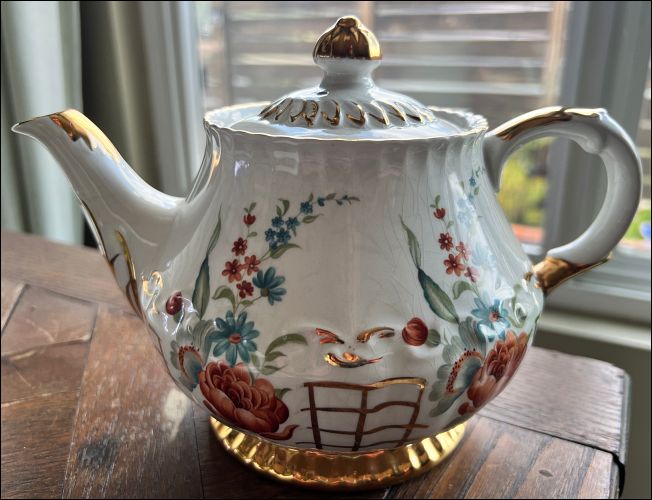
teapot in 'Alpine White' glaze, printed pattern with hand applied gilt |
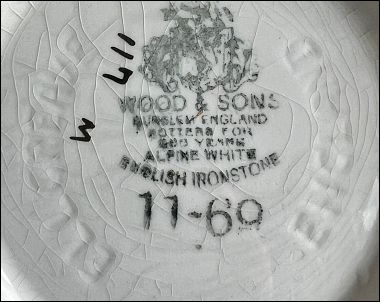 Wood & Sons Burslem England Potters for 200 years Alpine White English Ironstone Ellgreave England the printed 11-69 is the month-year of
manufacturer |
photos courtesy: Lynette Elles
Note on dates:
In common with many pottery companies , Wood & Sons would put dates on their ware which refers to preceding companies or earlier generations of the family. Marks on Wood & Sons ware from 1950 onward sometimes bear the description "POTTERS FOR 200 YEARS" -
Some ware bears a mark on which appears "RALPH 1750" "MOSES 1751" "ENOCH 1784" (sometimes just RALPH & ENOCH) - in spite of this, the ware bearing these dates does NOT date from the 1700's - these refer to three of the brothers of the Wood family. |
Marks used on ware for identification:
|
NOTE: early ware was not marked
WOOD & SON
c.1891-1907
WOOD & SONS
c.1907-10
WOOD & SONS LTD
c.1910+
NOTE: the company was
incorporated in 1910 and so all marks with 'LTD' are post 1910
many of the marks after 1910 did
not have 'LTD'
WOOD'S WARE
around 1917 marks with Wood's
Ware started to appear (with & Without an apostrophe)
- initially with the name Wood & Sons and then from around the early 1930's
without the name in full
Woods Ivory Ware
Woods Burslem
Woods Handicraft Ware
 Royal Patent Ironstone Wood & Son England mark incorporating the Royal Arms |
the 1/92 is the month/year of manufacturer - in this example January 1892 the impressed mark at the top is difficult to read - it is probably a registration number |
both these marks appear on the same white ironstone platter
Son
 Wood & Son England c.1891-1907 |
Sons
c.1907-10 |
Sons
Ltd
c.1910+ |

Marks
listed in 1917 Pottery Gazette Diary
The New
Wharf Pottery marks were introduced around 1878 - by
1894 the works were absorbed into the larger Wood & Son business
Marks
incorporating the Stafford Knot
 "SAXON" Made in England
|
 Seaforth Made in England |
 Sylvan Wood & Son England |
|
The registration number 55346 shows that pattern was registered on the 31st August 1886 to Wood & Son, Trent Pottery, Burslem | |
click below for more information:-
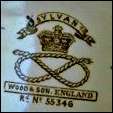
SYLVAN
[Stafford knot with crown
above]
WOOD & SON ENGLAND
Rd 56346
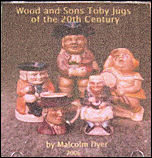
Wood and Sons Toby Jugs
of the 20th Century
Comments, questions, contributions? email: Steve Birks
|
Page created 1 January 2018 Last updated: 1 November 2025 |